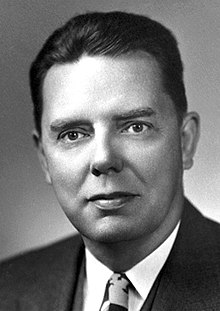Philip Showalter Hench
Philip Showalter Hench | |
|---|---|
 | |
| Born | February 28, 1896 |
| Died | March 20, 1965 (aged 69) Ocho Rios, Jamaica |
| Alma mater | Lafayette College University of Pittsburgh |
| Known for | Discovery of cortisone |
| Awards | Nobel Prize in Physiology or Medicine (1950) |
| Scientific career | |
| Fields | Medicine |
| Institutions | Mayo Clinic |
Philip Showalter Hench (February 28, 1896 – March 30, 1965) was an American physician. Hench won the Nobel Prize in Physiology or Medicine in 1950. He won the award along with his Mayo Clinic co-worker Edward Calvin Kendall and Swiss chemist Tadeus Reichstein . They won it for finding the hormone cortisone and its use for the treatment of rheumatoid arthritis."[1]
Hench went to university at Lafayette College in Easton, Pennsylvania. He was trained as a physician at the United States Army Medical Corps and the University of Pittsburgh. Hench began working at Mayo Clinic in 1923. He later became the head of the Department of Rheumatology.
Early life and education[change | change source]
He attended Lafayette College in Easton, Pennsylvania. At Lafayette, he earned his Bachelor of Arts in 1916. After that, he served in the Medical Corps of the U.S. Army and the reserve corps to finish his medical training. He got a doctorate in medicine from the University of Pittsburgh in 1920.[2] After getting his medical degree, Hench spent a year as an intern at St. Francis Hospital in Pittsburgh. Next, he became a Fellow of the Mayo Foundation.[2]
In 1928 and 1929, Hench studied at Freiburg University and the von Müller Clinic in Munich.[2]
Medical career[change | change source]
Hench started his career at Mayo Clinic in 1923. He worked in the Department of Rheumatic Diseases. In 1926, he became the head of the department. While at Mayo Clinic, Hench worked mainly on arthritic diseases. This lead him to believe that steroids lessened the pain caused by the disease.[2] During this time, biochemist Edward Calvin Kendall has found several steroids created by the adrenal gland cortex. After several years of work, Hench and Kendall decided to use one of these steroids on patients with rheumatoid arthritis.[2] Testing of the hypothesis was delayed because the synthesis of Compound E was costly and time-consuming, and Hench served in the military during World War II. The tests were conducted successfully in 1948 and 1949.[2] The steroid they used was named Compound E at the time. It later become known as cortisone.
Hench, Kendall and Swiss chemist Tadeus Reichstein won the 1950 Nobel Prize in Physiology or Medicine "for their discoveries relating to the hormones of the adrenal cortex, their structure and biological effects."[1] As of the 2010 prizes, Hench and Kendall are the only two Nobel winners who worked with Mayo Clinic.[3] During his career, Hench was one of the founding members of the American Rheumatism Association. He was its president in 1940 and 1941.
Hench also got the Heberdeen Medal (1942), the Lasker Award (1949), the Passano Foundation Award (1950), and the Criss Award.[2] Lafayette College, Washington and Jefferson College, Western Reserve University, the National University of Ireland and the University of Pittsburgh gave Hench honorary doctorates.[2]
References[change | change source]
- ↑ 1.0 1.1 "The Nobel Prize in Physiology or Medicine 1950". The Nobel Foundation. Retrieved 2011-07-04.
- ↑ 2.0 2.1 2.2 2.3 2.4 2.5 2.6 2.7 "Philip S. Hench". The Nobel Foundation. Retrieved 2011-07-04.
- ↑ "Nobel Laureates and Research Affiliations". The Nobel Foundation. Retrieved 2011-07-04.
Other websites[change | change source]
- Nobel Biography
- Biography Archived 2008-09-08 at the Wayback Machine
